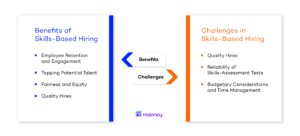The job market is currently undergoing a significant transformation, moving away from traditional norms that heavily favor academic qualifications towards a more inclusive approach that values practical skills and real-world experience. This shift, catalyzed by the rapid evolution of the digital economy and continuous technological advancements, is reshaping hiring practices across the globe. Companies have begun to prioritize skills and practical experience over formal degrees, indicating a profound change in employer preferences. This article explores the driving forces behind this shift, its benefits, real-life applications, and the potential challenges and solutions it presents.
“The broader adoption of hiring practices that emphasize the portability of skills is one of several approaches that could further expand occupational mobility and unlock the wealth of human capital held by workers without a bachelor’s degree.” [1]
The Driving Forces Behind the Shift
There are two major forces driving this shift in hiring, the first being the demand for employees. As many organizations struggle to find talent, they have had to do away with more traditional hiring methods and adapt in order to fill their vacant position. Ignoring potential candidates based on education alone is no longer a viable option and points towards a need for change, which has arrived in the form of skills-based hiring.
The second major force behind this shift is technological innovation. As technology evolves at an unprecedented pace, traditional educational curricula struggle to keep up, leaving a gap between the skills taught and those required in the workplace. This gap is particularly evident in the demand for digital literacy, which is becoming increasingly essential across all sectors, not just in tech-focused roles. Initiatives like the European Commission’s Digital Skills and Jobs Coalition highlight a collective effort to address this discrepancy by emphasizing the importance of skills and competencies over formal education credentials.
The Benefits and Challenges of Skills-Based Hiring
Transitioning to a skills-based hiring model presents both opportunities and challenges, as evidenced by real-life examples and studies across various industries. This model aims to focus on a candidate’s actual skills and abilities rather than traditional indicators like degrees and work history. While the benefits are significant, including improved employee retention, engagement, and diversity, the challenges cannot be overlooked.

Benefits of Skills-Based Hiring:
Employee Retention and Engagement: Organizations offering opportunities for employees to apply their skills see increased engagement and retention. Skills-based hiring matches candidates to roles where they can significantly contribute, enhancing job satisfaction and business outcomes. [2]
Tapping Potential Talent: By developing a skills repository, companies can identify employees with hidden talents, benefiting promotions and succession planning.[2]
Fairness and Equity: Using objective skill-assessment data in hiring decisions promotes fairness and equity in the workplace, improving employee morale and engagement.[2]
Quality Hires: Skills-based hiring promises a higher likelihood of quality hires by focusing on the specific skills required for the job, thus reducing biases and ensuring a better job match.[2]
Challenges in Skills-Based Hiring:
Operational Difficulties: Adding an extra stage for skills assessment can introduce operational complexities and concerns about slowing down the recruitment process.[3]
Reliability of Skills-Assessment Tests: There are questions about the quality and integrity of these assessments, which can also be time-consuming without the right tools.[3]
Budgetary Considerations and Time Management: With more applications to assess for skills, there are concerns about the cost and time required to administer these additional assessments.[3]
Adapting to Skills-Based Hiring
Skills Assessment and Work Sample Tests: One effective method is the use of work sample tests, where candidates perform tasks that simulate parts of the job, focusing on skills rather than experience. This approach tests practical application and helps identify candidates’ strengths and weaknesses.[4] To weed out candidates without the necessary skills before they even apply, recruiters should prepare detailed job descriptions that address what skills are required for the advertised role. With the help of Advanced Job Descriptions, applicants can dive deep into the company and the job to assess whether they fit the role and the team. This pre-selection helps to reach the right talent for your company.
Creating a Skills-Based Inventory: Transitioning to a skills-based organization involves creating a database of skills available within teams. This allows for a more dynamic and flexible approach to filling roles based on skills rather than specific job titles or career paths.[2] Radancy’s Candidate Relationship Management uses artificial intelligence to help you identify potential candidates in your talent pool based on their skills and thus fill open positions based on competencies.
Using Current Employees Networks: Employee referrals are a powerful strategy for adapting to skills-based recruiting, primarily because they leverage the existing workforce’s networks to identify candidates who not only have the required skill set but are also likely to fit well within the company culture. When employees refer someone they know, it’s usually because they understand the job requirements and genuinely believe that the person they are referring possesses the skills and attributes needed to succeed in that role. This pre-vetting process naturally leads to a pool of candidates who are more closely aligned with the company’s specific skill needs.
While skills-based hiring offers a more equitable and efficient way to match talent to roles, the challenges highlight the need for careful implementation. Organizations must consider these factors to ensure a balanced approach that values both skills and the foundational knowledge provided by formal education.
“… job training and hiring practices that emphasize transferrable skills could help employers efficiently fill in-demand or hard-to-fill positions and provide new career opportunities for workers who have been laid-off, furloughed, or simply want a career change.” [5]
Real-Life Examples of Skills-Based Hiring
Siemens AG and the UK’s Tech Talent Charter are notable examples of entities that have embraced skills-based hiring practices, which prioritize the competencies and abilities of individuals over traditional academic credentials. These practices aim to bridge skill gaps internally within organizations and promote diversity and inclusiveness in the workforce.
Siemens AG, for instance, focuses on understanding the impact of new technologies on workforce skill demands and employs a strategic approach to skill development. They emphasize the need for continuous learning and have established extensive training programs to ensure that their workforce remains competitive in the face of technological advancements. Siemens highlights the importance of identifying skill demands and creating appropriate training measures, either through existing programs or by developing new ones tailored to specific needs.[6]
The UK’s Tech Talent Charter (TTC) is another example that highlights a shift towards skills-based hiring. It represents a commitment across the tech industry to increase diversity and inclusiveness by focusing on competencies rather than academic qualifications alone. While the TTC specifically targets the tech industry in the UK, its principles are gaining traction globally as companies recognize the value of a diverse and skilled workforce over traditional hiring criteria.
Moreover, McKinsey’s insights on taking a skills-based approach to building the future workforce further elucidate the practical benefits of such practices. It outlines how creating skills-based pathways can aid employee development through various stages, from identifying potential future roles within the company to developing specific training programs to prepare employees for these roles. This not only makes employers more resilient in times of economic uncertainty but also provides employees with secure and fulfilling career development opportunities. The approach involves a shift from traditional career progression paths to more dynamic and skills-oriented models, allowing for a more agile and responsive workforce that can adapt to changing market demands.[7]
Additionally, Built In discusses the broader benefits of skills-based hiring, emphasizing how it leads to a more diverse and inclusive talent pool, boosts employee engagement and retention, and saves time and money by improving job matches. Skills-based hiring is presented not as a fleeting trend but as a fundamental shift in talent management that leverages objective data to reduce bias and focus on the actual abilities needed for specific roles. The process involves moving from traditional job descriptions and hiring practices to ones that focus on evaluating and assessing the specific skills required for a job, thereby improving overall job performance and satisfaction.[2]
These examples and insights highlight the growing recognition of skills-based hiring as a valuable strategy for enhancing workforce diversity, competitiveness, and adaptability in a rapidly changing global economy.
Moving Towards a More Inclusive Future
The shift towards skills-based hiring in Europe signifies a crucial evolution in employment practices, promising a future of greater flexibility, inclusivity, and alignment with the modern workforce’s needs. This approach not only benefits job seekers and employers but also contributes to a more dynamic and resilient economy. As European companies continue to lead by example, the principles of skills-based hiring could redefine employment pathways, offering opportunities based on skill merit and potential for growth.
This ongoing shift highlights the importance of continuous learning and adaptability for job seekers, underscoring the need to acquire and showcase relevant skills. For employers, it offers a chance to revolutionize recruitment processes, focusing on the capabilities that genuinely matter for job performance. Embracing a skills-based approach is crucial for tapping into the full potential of Europe’s workforce, ensuring a thriving future for individuals and organizations alike.
Sources:
[1] Butrica, B. A., & Mudrazija, S. (2022). Skills-Based Hiring and Older Workers. Washington, DC: Urban Institute.
[2] Purewal, R. (2023, May 2). Skills-based hiring: What it is and why it works. Built In. https://builtin.com/recruiting/skills-based-hiring
[3] Symonds, C. (2023, August 22). Skills-based hiring: What talent leaders need to know. Factorial. https://factorialhr.com/blog/skills-based-hiring/
[4] Caccavale, J. (2022, July 26). Skills-based hiring: The essential guide. BeApplied. https://www.beapplied.com/post/skills-based-hiring
[5] Federal Reserve Bank of Cleveland. (2020, June 24). Exploring a Skills-Based Approach to Occupational Mobility. Notes from the Field. https://www.clevelandfed.org/publications/notes-from-the-field/2020/nftf-20200624-a-skills-based-approach-for-transitioning-workers-to-higher-paying-occupations
[6] Beitinger, G. (2020, December). Understanding and managing the impact of new technologies on workforce skill demands. Siemens Blog. https://blog.siemens.com/2020/12/understanding-and-managing-the-impact-of-new-technologies-on-workforce-skill-demands/
[7] Hancock, B., Higgins, C., Law, J., Olson, S., Patel, N., & Van Dusen, K. (2022, November 15). Taking a skills-based approach to building the future workforce. McKinsey & Company. https://www.mckinsey.com/capabilities/people-and-organizational-performance/our-insights/taking-a-skills-based-approach-to-building-the-future-workforce




















